Variation in key soil properties after eleven years of poplar plantation in calciorthents of Bihar
Keywords:
Agroforestry, Bulk density, Poplar, Soil organic carbonAbstract
Poplar based agroforestry systems are economically viable and more sustainable than many other crop rotations prevalent in northern India. In Bihar, about 57.2% land is under agriculture and little scope for cultivating trees of long gestation/ rotation period (25-60 years). The doubling of the growth rate of food production is still required to feed the rapidly increasing population. In recent years, poplar has emerged as a popular short rotation tree for agroforestry in north and eastern India. A study was undertaken for 11 years to judge the suitability of different poplar clones (PP-5, Uday, L-52, L-49, G-48 and L-188) along with control (treeless) plots on key soil properties. The results revealed that irrespective of poplar clones, there was significant decrease in soil pH, electrical conductivity (EC), soil bulk density and increase in soil organic carbon content (SOC) as well as soil organic carbon density (SOCD) for both surface (0-15 cm) and subsurface (15-30 cm) soil resulted in better soil conditions for crop growth under agroforestry system. In terms of soil properties and environmental sustainability, among studied poplar clones, L-52 and L49 emerged as best clones for cultivation and promotion under calciorthent soils of Bihar.




